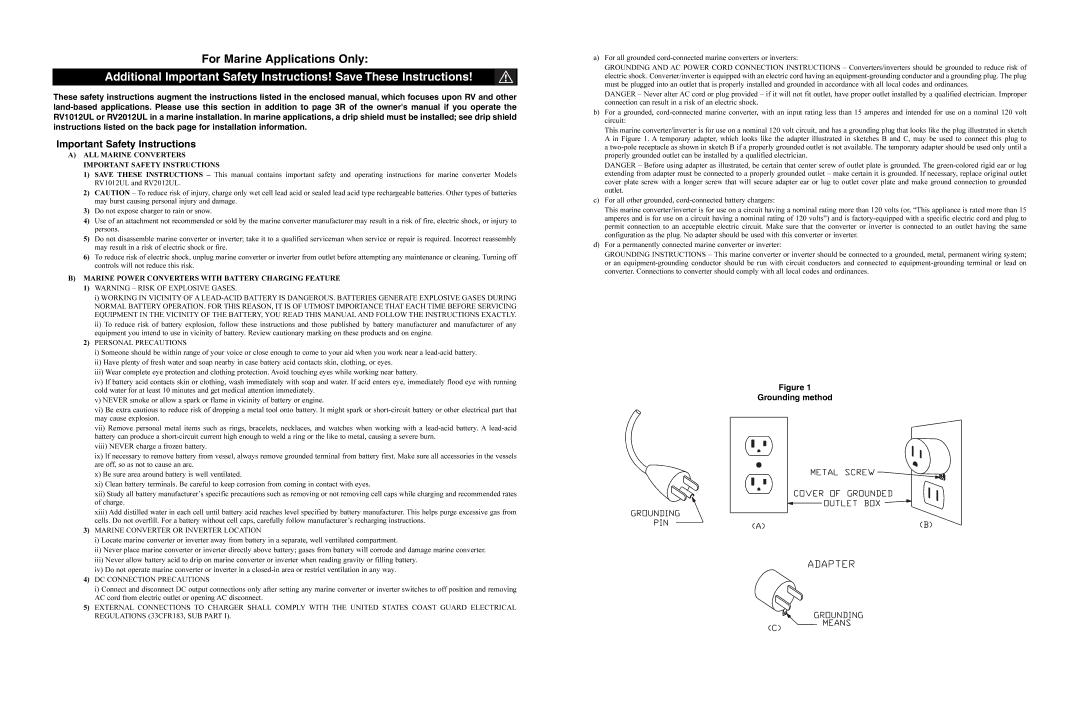
For Marine Applications Only:
Additional Important Safety Instructions! Save These Instructions!
These safety instructions augment the instructions listed in the enclosed manual, which focuses upon RV and other
Important Safety Instructions
A)ALL MARINE CONVERTERS IMPORTANT SAFETY INSTRUCTIONS
1)SAVE THESE INSTRUCTIONS – This manual contains important safety and operating instructions for marine converter Models RV1012UL and RV2012UL.
2)CAUTION – To reduce risk of injury, charge only wet cell lead acid or sealed lead acid type rechargeable batteries. Other types of batteries may burst causing personal injury and damage.
3)Do not expose charger to rain or snow.
4)Use of an attachment not recommended or sold by the marine converter manufacturer may result in a risk of fire, electric shock, or injury to persons.
5)Do not disassemble marine converter or inverter; take it to a qualified serviceman when service or repair is required. Incorrect reassembly may result in a risk of electric shock or fire.
6)To reduce risk of electric shock, unplug marine converter or inverter from outlet before attempting any maintenance or cleaning. Turning off controls will not reduce this risk.
B)MARINE POWER CONVERTERS WITH BATTERY CHARGING FEATURE
1)WARNING – RISK OF EXPLOSIVE GASES.
i)WORKING IN VICINITY OF A
ii)To reduce risk of battery explosion, follow these instructions and those published by battery manufacturer and manufacturer of any equipment you intend to use in vicinity of battery. Review cautionary marking on these products and on engine.
2)PERSONAL PRECAUTIONS
i)Someone should be within range of your voice or close enough to come to your aid when you work near a
ii)Have plenty of fresh water and soap nearby in case battery acid contacts skin, clothing, or eyes.
iii)Wear complete eye protection and clothing protection. Avoid touching eyes while working near battery.
iv)If battery acid contacts skin or clothing, wash immediately with soap and water. If acid enters eye, immediately flood eye with running cold water for at least 10 minutes and get medical attention immediately.
v)NEVER smoke or allow a spark or flame in vicinity of battery or engine.
vi)Be extra cautious to reduce risk of dropping a metal tool onto battery. It might spark or
vii)Remove personal metal items such as rings, bracelets, necklaces, and watches when working with a
viii)NEVER charge a frozen battery.
ix)If necessary to remove battery from vessel, always remove grounded terminal from battery first. Make sure all accessories in the vessels are off, so as not to cause an arc.
x)Be sure area around battery is well ventilated.
xi)Clean battery terminals. Be careful to keep corrosion from coming in contact with eyes.
xii)Study all battery manufacturer’s specific precautions such as removing or not removing cell caps while charging and recommended rates of charge.
xiii)Add distilled water in each cell until battery acid reaches level specified by battery manufacturer. This helps purge excessive gas from cells. Do not overfill. For a battery without cell caps, carefully follow manufacturer’s recharging instructions.
3)MARINE CONVERTER OR INVERTER LOCATION
i)Locate marine converter or inverter away from battery in a separate, well ventilated compartment.
ii)Never place marine converter or inverter directly above battery; gases from battery will corrode and damage marine converter.
iii)Never allow battery acid to drip on marine converter or inverter when reading gravity or filling battery.
iv)Do not operate marine converter or inverter in a
4)DC CONNECTION PRECAUTIONS
i)Connect and disconnect DC output connections only after setting any marine converter or inverter switches to off position and removing AC cord from electric outlet or opening AC disconnect.
5)EXTERNAL CONNECTIONS TO CHARGER SHALL COMPLY WITH THE UNITED STATES COAST GUARD ELECTRICAL REGULATIONS (33CFR183, SUB PART I).
a)For all grounded
GROUNDING AND AC POWER CORD CONNECTION INSTRUCTIONS – Converters/inverters should be grounded to reduce risk of electric shock. Converter/inverter is equipped with an electric cord having an
DANGER – Never alter AC cord or plug provided – if it will not fit outlet, have proper outlet installed by a qualified electrician. Improper connection can result in a risk of an electric shock.
b)For a grounded,
This marine converter/inverter is for use on a nominal 120 volt circuit, and has a grounding plug that looks like the plug illustrated in sketch A in Figure 1. A temporary adapter, which looks like the adapter illustrated in sketches B and C, may be used to connect this plug to a
DANGER – Before using adapter as illustrated, be certain that center screw of outlet plate is grounded. The
c)For all other grounded,
This marine converter/inverter is for use on a circuit having a nominal rating more than 120 volts (or, “This appliance is rated more than 15 amperes and is for use on a circuit having a nominal rating of 120 volts”) and is
d)For a permanently connected marine converter or inverter:
GROUNDING INSTRUCTIONS – This marine converter or inverter should be connected to a grounded, metal, permanent wiring system; or an
Figure 1
Grounding method
